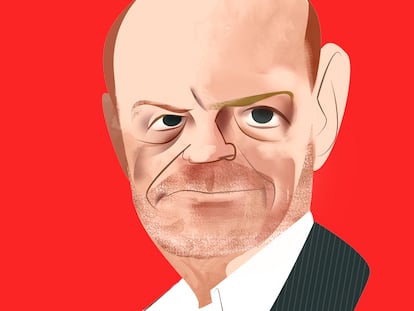Ben Smith, journalist: ‘On Twitter/X, we’re only left with depraved journalists and politicians yelling at each other’
The reporter has firsthand experience with the changes of the last 20 years on the border between technology and information. He now recounts the rise and fall of viral content in a new book

Ben Smith, 47, has been part of journalism’s efforts to survive in the internet era. He started with blogs at Politico, then went on to exploit viral content on social media with BuzzFeed News. From there, he rose to become a media columnist at The New York Times, where he witnessed the success of the new paywalls. Today, he’s the co-founder of Semafor, an online news platform that aspires to become a reference for the current era, calling for greater transparency and more authentic voices.
Earlier this year, the NYC-born journalist published a book titled Traffic about his past two decades in the media. He discusses how an era is ending, as the platforms that channeled online news traffic, especially Facebook, have found that journalism isn’t good for business.
So what comes next? In his interview with EL PAÍS, conducted via videoconference, he reflects on the end of this era, as well as on the death of social media as the public square. Clearly, there are many deaths that need to be processed.
Question. Will social media soon die as the center of public debate?
Answer. It’s already happening. With Facebook, it’s obvious. And with Twitter (or X), it’s been happening for years… you just didn’t really realize it. When was the last time a celebrity posted something on X? Maybe five years ago. The famous people are gone, the majority of athletes left. Most of the companies have disappeared [from the site]. We’re just left with depraved journalists and politicians screaming at each other.[Twitter] will still be a great place to watch sports. Maybe they can build a big sports betting business. It doesn’t mean it’s going to disappear, but [there will be] a cultural change.
Q. It will be a smaller place.
A. It’s no longer what it was two years ago. I still really love Twitter (he has 341,000 followers). I have no complaints… but [from a news consumer’s standpoint], I think the idea that you get your news by walking into an insane asylum is a little uncomfortable, it’s not a good experience.
Q. What alternatives are there today?
A. TikTok is an amazing platform, but it’s obviously not for news. When I say “news,” I’m sort of talking about the elite sociopolitical cultural conversation. That doesn’t happen on TikTok. Many other interesting things happen there… but it’s more of an entertainment platform.
Q. Newsletters sent via email have become another possible alternative.
A. Yes, more and more so. Email is a primary distribution channel – I certainly get a lot of my news now through newsletters. Which also seems strange: it’s a technology from the 1990s. Still, I don’t think email is the end point of all human technology.
Q. Even Google survives as a distribution channel.
A. Google is still important for publishers, especially for media outlets that focus on lifestyle content. But I guess Google isn’t such an inspiring source of information anymore.
Q. Traditional social media platforms are dying, TikTok is something else, newsletters aren’t scaling, Google is old. Have the media distribution channels become complicated?
A. It’s much harder to be known than it used to be. I feel very fortunate to have launched Semafor when Twitter still existed, [because] many news consumers have now moved on. We advertised on Twitter before launching [in January of 2022] and it was effective.
Q. It’s more difficult to find new sources of information.
A. It’s true. Things are very fragmented. It’s harder to be a news consumer now. It’s not that anyone wants to go back to having a single source… but social media is now like walking through a nuclear wasteland searching for radioactive nuggets.
Really enjoying the book Traffic by Ben Smith, though the font makes it look a bit like the title is actually commanding someone to do something pretty unseemly to poor Ben. pic.twitter.com/SiV9CFWiaD
— Shawn Fury (@shawnfury) May 12, 2023
Q. Large media outlets have the advantage of attracting audiences due to their size, tradition and names.
A. Yes, but it’s still a big problem [for them]. I imagine it’s also a big opportunity for publishers, because it’s a big huge problem for consumers. I don’t think there’s an easy solution.
Q. What about the media homepage?
A. Homepages are interesting, they’ve been more resilient than we expected.
Q. It’s almost nostalgic.
A. We’re in a moment of great nostalgia for the old days. The New York Times tells you, “come into our walled garden, where you can only read our articles… you can share our politics and everything will be simple again.” Then, other media outlets say: “We’re going to continue exploiting the radioactive wasteland of social media and get some uranium.” But the real answer has to be that we have to find some way to regain trust in the institutions that preceded social media. I also don’t think anyone wants to go back to a world where you only see one source and have to trust it. People are already used to having multiple perspectives… that’s not going away.
Q. Why didn’t social media work in the news business?
A. The [big social media sites] believed that their business model and our journalism would be aligned. It wasn’t so much that they’re the bad guys – I think we made a wrong prediction about their choices. One of the things you have to understand before understanding this ecosystem is the extent to which people were thinking about cable television as a model, as a new type of distribution. [Different platforms] began to compete with each other – they would need better and better content. But if we were going to supply [the social media platforms] with content, we would need to start charging them. That’s what never happened. They simply decided that they would rely on user-generated content forever. Mainly because it’s free, but also because political news and politics became a huge challenge for the platforms.
Q. The money that online traffic promised never reached the media.
A. No. Journalism isn’t a particularly efficient way to reach large audiences for little money.
Q. Journalism wasn’t worth it for the social media platforms.
A. We have to forget about them. The Silicon Valley dream totally excludes professional journalism. It makes our products irrelevant. It’s a mix of ideology and probably something more practical… [and it’s also] more fun to have things for free than to have to pay for them.
Q. Is there a technological solution for the field of journalism?
A. There’s this kind of fantasy in the industry that, for journalism, there’ll be a kind of silver bullet that will solve everything. Tech entrepreneurs love the idea of discovering the secret… but the news business doesn’t work like that. It’s difficult, even more so now. We’re successful companies that do a lot of different things… we do them quite well, we sell advertising, we sell subscriptions. There’s no sexy answer to the big questions. It’s more about executing projects well, working hard, building an audience and then doing different things. To some extent, you just do what makes sense and works. It’s less ideological. I know it’s a boring answer, but you only have to look at media companies that have really been successful. Disney, for example. What’s their business? They have 15 different things, but it’s fine. They’re the best media company out there and they’re still a disaster.

Q. One of Semafor’s promises is to be more transparent. Can a legacy organization such as The New York Times be transparent?
A. It’s a big challenge. Their strength is actually their brand and they require a certain homogenization. They’re doing lots of different things. But if you look at the news article, it’s a kind of black box: it’s a set of statements… some of them are facts and some of them are analysis. Maybe it’s the journalist’s analysis, or maybe it’s the editor’s analysis, or maybe it’s the official position of the publication. From the outside, you don’t really know which is which. Do you know that a journalist wrote it? No, you don’t know if every word is theirs and what their opinion is… although you can guess, based on who they quote and how they spin the story.
Q. What was your experience at The New York Times like?
A. When I was there, only a couple of people were allowed to write normally: the media columnist and the municipal columnist. Historically, those two journalists can write like normal people… but everyone else has to write like ChatGPT. I don’t think it’s a very contemporary way of communicating. It leaves readers confused about who they’re actually listening to.
Q. And that’s why newsletters work.
A. They’re just more natural. They let the reader know who they’re listening to.
Q. What has journalism gained from the era of clickbait ?
A. Journalism in the United States was more interesting when there were 10 newspapers in each city. It was more entertaining and more emotional. Then, there was an intermediate period where the newspapers were consolidated into a few [big names]. There were monopolies and they became very boring. But that was only for a moment.
Q. So we’re back to something like before, even for the big guys like The New York Times.
A. Yes, [the publications] are more fun, more human… also more politicized.
Q. And the clickbait headlines?
A. You know, I don’t really buy the clickbait headline thing. Headlines were always meant to be interesting. To get people to read stories, there have always been crazy headlines in journalism.
Q. The problem is promising more than the piece can offer.
A. Sure, that’s bad. Misleading headlines are clearly bad. But I think people use the word “clickbait” to refer to any headlines other than “Congress will meet tomorrow to consider serious things.” And that’s not fair.
Q. Can a business be built today around online traffic?
A. If you keep costs very low, yes. You can make money and build a traffic-based media business. But everything has to be very cheap. So you can’t do journalism.
Sign up for our weekly newsletter to get more English-language news coverage from EL PAÍS USA Edition
Tu suscripción se está usando en otro dispositivo
¿Quieres añadir otro usuario a tu suscripción?
Si continúas leyendo en este dispositivo, no se podrá leer en el otro.
FlechaTu suscripción se está usando en otro dispositivo y solo puedes acceder a EL PAÍS desde un dispositivo a la vez.
Si quieres compartir tu cuenta, cambia tu suscripción a la modalidad Premium, así podrás añadir otro usuario. Cada uno accederá con su propia cuenta de email, lo que os permitirá personalizar vuestra experiencia en EL PAÍS.
¿Tienes una suscripción de empresa? Accede aquí para contratar más cuentas.
En el caso de no saber quién está usando tu cuenta, te recomendamos cambiar tu contraseña aquí.
Si decides continuar compartiendo tu cuenta, este mensaje se mostrará en tu dispositivo y en el de la otra persona que está usando tu cuenta de forma indefinida, afectando a tu experiencia de lectura. Puedes consultar aquí los términos y condiciones de la suscripción digital.
More information
Archived In
Últimas noticias
Most viewed
- Sinaloa Cartel war is taking its toll on Los Chapitos
- Oona Chaplin: ‘I told James Cameron that I was living in a treehouse and starting a permaculture project with a friend’
- Reinhard Genzel, Nobel laureate in physics: ‘One-minute videos will never give you the truth’
- Why the price of coffee has skyrocketed: from Brazilian plantations to specialty coffee houses
- Silver prices are going crazy: This is what’s fueling the rally











































